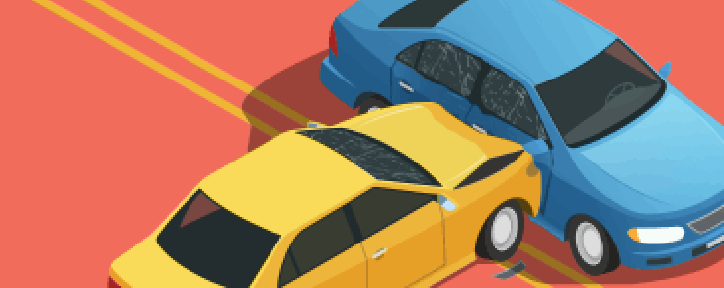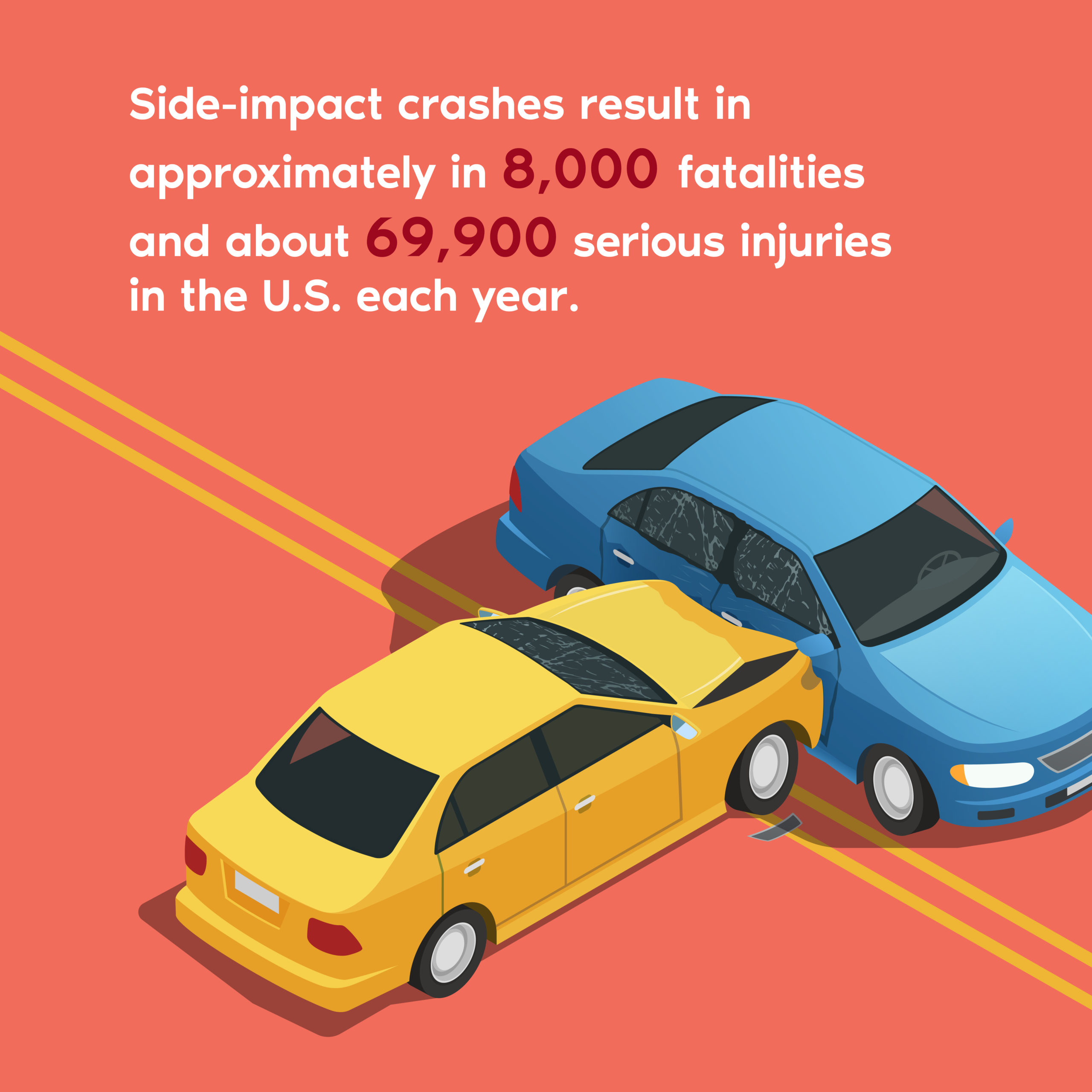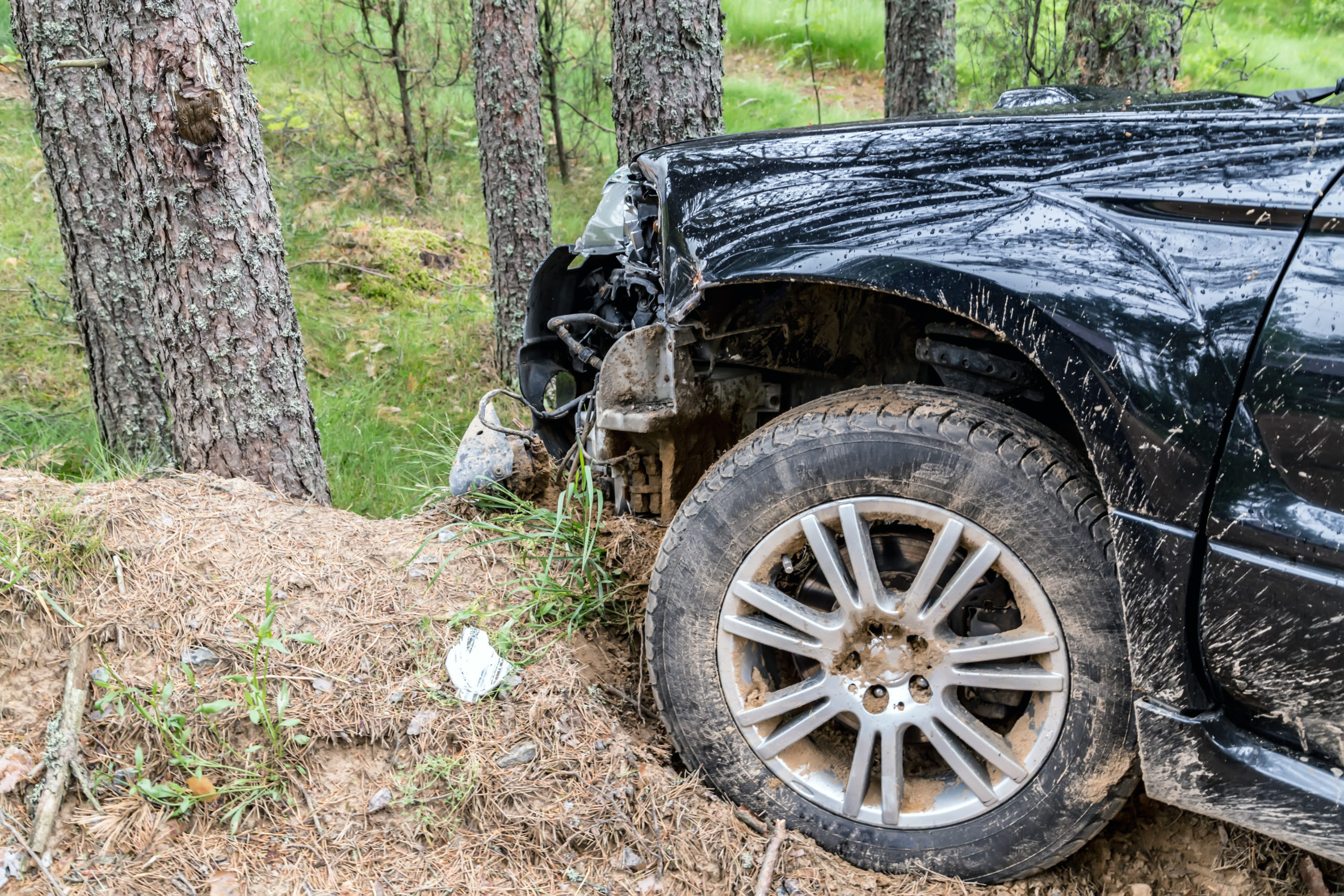
In New Jersey, there are between 270,000 and 280,000 auto accidents each year, of which about a quarter occur at intersections, where side-impact accidents are common. These kinds of crashes can result in serious injuries to both passengers and drivers in either vehicle involved in the crash. While all auto accidents are dangerous, side-impact crashes, in particular, result in approximately 8,000 fatalities and about 69,000 serious injuries in the U.S. each year.
Those involved in side-impact crashes may find themselves in a position to file a personal injury lawsuit. Such a lawsuit can help recover money needed to pay medical bills, replace wages from being out of work (temporarily or permanently), and to compensate for pain and suffering. It is critical in any scenario that a person hire a highly skilled and well-qualified personal injury attorney.
What Is a Side-impact Collision?
A side-impact collision is sometimes called a “T-bone” collision. This is because many side-impact crashes involve one vehicle striking another vehicle’s side at or about a 90-degree angle (thus forming a “T” shape). Technically, a side-impact accident can include any accident in which the front or rear of a vehicle hits the side of another, regardless of angle. The term “broadside impact” is often used to describe these crashes too, although this term can also encompass sideswipe accidents, which are very different from side-impact crashes.

Causes of Side-impact Accidents
Side-impact crashes most often occur at intersections and in parking lots. These are two scenarios when vehicles can travel perpendicular to each other. The most common reasons why such accidents occur in these situations include:
- Running a red light or stop sign
- Speeding
- Texting or cell phone use while driving
- Improper passing
- Driving while intoxicated
Side-impact crashes can also be caused by more than traffic violations. For example, many accidents are the result of
- Aggressive driving
- Distracted driving (e.g. eating or changing the radio station)
- Fatigued driving
- Poor road conditions (e.g., wet or icy)
- Road defects
- Vehicle defects (e.g., a tire blowing or steering problem)
In addition, when multiple vehicles are involved in an accident, it is possible for one to be struck, spin around, and then either strike or be struck in a secondary side-impact crash.
What Contributes to Severity?
The sides of a car cannot redirect or absorb energy in the same way the front or rear of a vehicle. The front and back have bumpers, crumple zones, and are typically better able to withstand the brunt of an impact.
Side airbags can prevent someone from striking the side window in T-bone collisions, but they cannot necessarily lessen the raw force that whips the human body around. Similarly, seat belts are designed to prevent a person from jolting forward in a crash but do little to reduce movement from side impacts.
Another key reason side-impact crashes are so serious is that drivers and/or passengers are often only inches away from the point of impact. By contrast, a driver or front passenger in a rear-end collision has either the buffer length of the vehicle’s hood (if in the striking car) or the full length of the vehicle’s body (if in the car that is struck).
Although side impacts are more dangerous than impacts to the front or back of a car, manufacturers can take steps to make their cars safer in the event of a side impact. If a car could reasonably have been designed to be safer and the manufacturer’s failure to use this safer design leads to an injury, the manufacturer can be held liable. For example, in Rider v. Township of Freehold, a court upheld a $6.9 million verdict against BMW because its failure to reinforce the frame of one of its models led to a driver’s death in a side-impact collision.
Potential Injuries
According to the University of Michigan research, side-impact crashes most often result in injuries to the head, chest, pelvis, and abdomen. The report indicates that the injuries are the result of intrusion into the vehicle cabin. In other words, the side or door of the car bends inward. This results in flying glass, metal, as well as potential impact in sharp or bulging edges of the deformed surface. Specifically, drivers and passengers can suffer:
- Broken ribs
- Concussions and traumatic brain injuries
- Damage to the lung and diaphragm
- Injuries to the leg and/or knee
- Lacerations from windows or flying glass
- Pelvic fractures
- Spleen injuries
- Spinal injuries
Fatality Rate on Side-impact Collisions
According to the Insurance Institute for Highway Safety, 23% of fatal crashes involving two more vehicles are side-impact crashes. This is the second-highest fatality rate, behind front-impact crashes. New Jersey does not offer data specific to side-impact accidents. However, the New Jersey Department of Transportation does note that nearly 57,000 accidents involving two or more vehicles occur at intersections, where side-impact crashes are most common. Of those, more than 12% involve vehicles colliding at an angle, such as in a side-impact accident.
Determining Fault
Insurance companies and personal injury attorneys will use a variety of factors to determine which party or parties are at fault, and if so to what extent. Among the evidence that can be used include:
- Statements made by the drivers and/or passengers. Those who say too much or admit fault (inadvertently or otherwise) increase the likelihood they will be found partially or entirely liable.
- Witness testimony. Impartial eye-witnesses, including other drivers or pedestrians, can provide critical neutral information.
- The speed of each vehicle. A driver who accelerated moments before impact, or who was speeding could bear more liability in a crash. This can be proven by either eyewitness testimony or forensic evidence. For example, in Auttika Taing v. Braisted, the defendant tried to argue he could not have been speeding because the side airbags in the victim’s car did not deploy. Although the court did not allow the defendant to use this evidence because he did not have an engineer testify to explain its significance, the court left open the possibility of defendants using it in other cases.
- Whether any traffic laws were violated in the lead-up to the accident. A driver who ran a red light, for example, will likely shoulder more of the blame.
- Weather conditions. Drivers are expected to adjust their behavior when operating in the rain, snow, fog, or other inclement weather. Those who are driving inappropriately for the conditions are more likely to be seen as at fault for an accident.
- Condition of the vehicles. A vehicle must be in working condition in order to be legally operated on New Jersey roads. Faulty brakes, cracked or dirty windshields, broken speedometers, and other mechanical issues can increase liability in crashes.
Filing a Claim
There are several important things a person should do in the wake of a side-impact car accident. This includes taking photos of the crash scene, exchanging contact information with the other driver(s) and passengers, and seeking immediate medical attention.
In order to win a personal injury lawsuit against another driver in New Jersey, a person must show that he/she is less than 50% at fault for the accident. In addition, the person suing must show that the accident resulted in financial loss and/or serious pain or other emotional trauma (including the death of a loved one).
Even if a person was at fault for a car accident or if their injury is not permanent enough to sue another driver, they are still eligible to receive personal injury benefits from their own car insurer. However, these benefits only cover medical bills, and only up to the policy limit. To receive full compensation for an injury, it is often necessary to file a lawsuit against the other driver.

Case Study: $21 Million Award
What makes this case unique: Defense witness testified in favor of plaintiff; judge was a former Attorney General who had lost a substantial case to Mr. Rosenblum years earlier; Appellate Court actually increased the award amount.
Frequently Asked Questions
Whiplash is not relegated to rapid front-and-back movement. A person can get whiplash from a side-impact crash by jolting the neck suddenly to the left or right. That’s why it’s important to seek medical attention after such an accident. You want to be sure all possible injuries are diagnosed or ruled out.
A person making a left turn may have right of way in many scenarios, which would affect how much fault he/she bears in an auto accident. For example, if the person entered an intersection to make a left while the light was green and is T-boned by a driver who ran a red light the left-turning driver may not be at fault.
T-bone crashes often occur in parking lots. Although parking lots are considered private property in many ways, if an accident results in a police report being filed then it is likely to appear on one’s driving record.
Drivers are expected to take road conditions into account. As such, a driver who skids through an intersection and causes a side-impact accident can be held liable as he/she could have reduced speed or taken other precautions to prevent the vehicle from hydroplaning.
Who Should I Contact?
Injuries from a side-impact car accident can have potentially lifelong consequences. If you or someone you love has been injured in a crash, contact Rosenblum Law today. Our experienced team of aggressive New Jersey personal injury lawyers has a record of recoveries in all types of NJ personal injury cases. E-mail or call 888-815-3649 for a free consultation.


